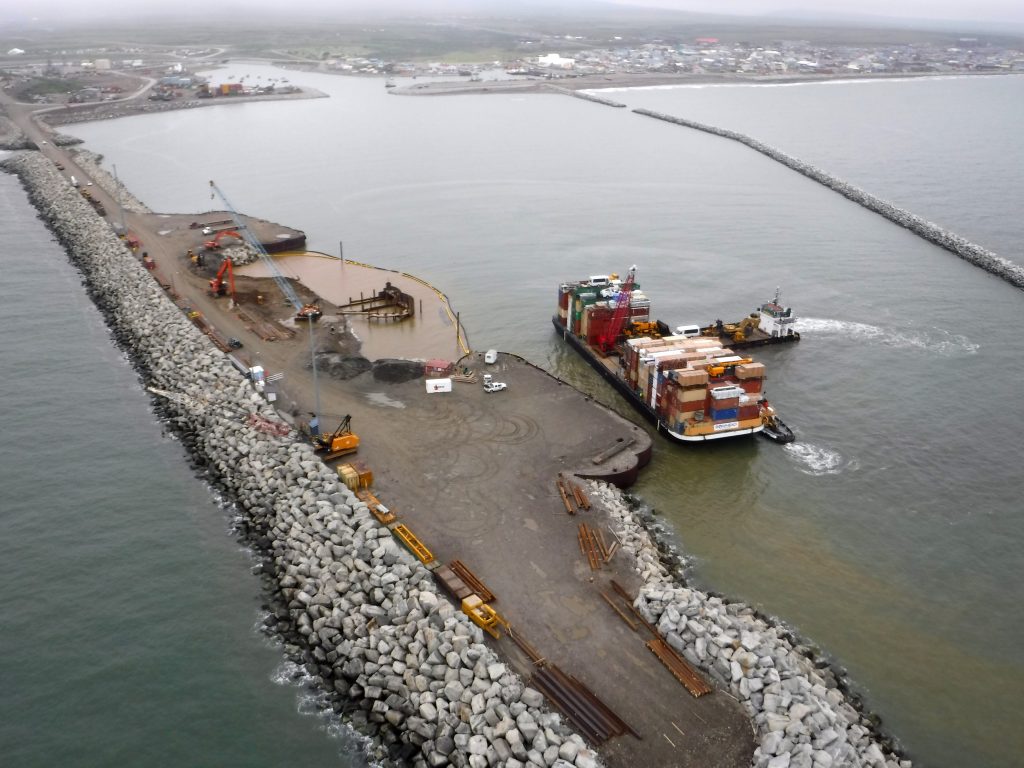The US federal government has greenlighted the next phase of Nome’s port expansion
Recently passed legislation authorizes, but doesn’t yet fund, the port's deep-draft upgrades.

Late last month, Congress passed the Water Resources Development Act of 2020, which authorizes — but not yet fund — a long-awaited expansion of the port in Nome, Alaska.
The legislation means the port of Nome can move forward with design plans and securing potential funding from other partners for the expansion.
Once complete, the expanded port would serve as the only deep-draft port in the U.S. Arctic region. Currently, the closest such port is Dutch Harbor, some 1,000 miles south of the Arctic Circle.
The plan to expand the Nome port won approval from the U.S. Army Corps of Engineers in May.
Under the plan, the existing causeway of the port would be extended by nearly 3,500 feet, and an outer basin dredged to 40 feet — almost twice the current depth of 22 feet — to accommodate icebreakers, fuel tankers and large cruise ships.
The estimated cost of expansion is now $505 million. Of that amount, the bill authorizes the federal government to pay $378.9 million, and the city of Nome and other partners would provide $126 million.
In Congress, authorizations are seen as a recommendation of sorts for appropriators setting aside funds in budget committees. Authorizations do not mean any money has been promised or disbursed.
“The project is authorized. None of the funding is authorized,” Joy Baker, Nome’s port director, told ArcticToday.
The project authorization enables the city and the Corps to move forward with the design phase, which takes about two years. During that time, Baker hopes the port will be funded by Congress in the fiscal year 2022 or 2023 budget so work can begin as soon as the design is complete.
“As soon as the design phase is over, the schedule typically just jumps right into preparing the bidding documents and contracts, and put it out to bid,” Baker said.
In addition to federal funding, the port has been in discussions with funding agencies, local partners and investors for several years. “But all we could do was talk, because the project wasn’t authorized,” Baker said.
Now, while officials wait for the construction funds to be appropriated through Congress, “we will then start getting more defined in our relationships with our partners for our share” of costs, Baker said.
Last year, prior to the Corps’ approval of the expansion plan, Kawerak Inc. outlined several outstanding issues to be addressed, including the protection of subsistence hunting, consideration of the health and well-being of the community, and evaluation of environmental risks. These are issues the designers may take under consideration as the plan moves forward.
The heavy icebreaker Polar Star, currently on its first Arctic wintertime mission in decades, needs to return to Dutch Harbor for each refuel and resupply.
Deepening the Nome port would save time and money on icebreaker missions all year round, Baker said. “They could just pop over to Nome for refueling, crew changes and perishables, and then get back out.”
Resupplying the national security fleet in the Arctic has been one of the driving reasons for these changes, she said. “They would have no need to go to Dutch if we were 40 feet.”